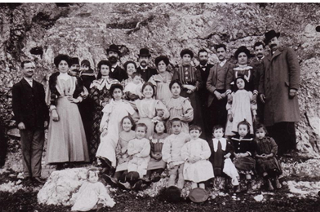
Τhe tale of the Yussuroums
“Group photo of the Yussuroum, Habib and Cohen families in Thiseio,around 1914. In the back row, the fivechildren of Bochor Yussuroum, Elias (with beard and hat), Chaim, Yakov, Mois,and Noah, with their spouses and children, the family’s third generation. In the middle, Noah’s wife, Mazaltov (neeHabib) with newborn Isaac in her arms. K.E.T.E.S.(Hellenic Army Research and Technology Center):
Thestories about Athens and its people are countless. Many of them have faded with time, others liedormant or have been forgotten. Stillothers crop up every once in a while to become remnants of the past; and fromfragments become narratives. The storyof the Yussuroum family is an Athenian tale, charming and distant, yet fresh,au-courant and real, just as is the legacy of this family name often used inthe vernacular to mean “flea market.” Afew days ago, the Jewish community of Athens bestowed the honor of greatbenefactor upon Mr. Mois Yussuroum, aged 95, for his decades of voluntaryservice, and in so doing renamed the atrium of the community’s synagogue in hishonor. This act of public homageinspired the Jewish Museum in Athens and Jewish community to search archivesthat might shed light on the Yussuroum family’s background and to document its history.
We all know what the word “yussuroum” means; few, however, associate anantique shop or antique bazaar with this Jewish family name. Mr. Mois Yussuroum is a descendant of a long lineof successful merchants who influenced the commercial landscape of Athens. The Yussuroum family’s home at Karaiskaki 1and Ermou Streets, in the heart of the old city’s commercial district, housed thefirst synagogue in Athens. At the end ofthe 19th century, this was the hub of the Jewish community. It was also the hub of the Yussuroum family’sbusinesses. And the surrounding streets,bustling with the activity of small merchants, was known as the old “Jewishquarter.” It was the area bounded byAgion Asomaton, Sarri and Ermou Streets as well as Agiou Filippou andIndependence (Anexartisias) Squares.
Older traces of the family tree have been lost in time; however, likemany Sephardic Jews that have become part of Greece’s fabric in more recenthistory, the Yussuroum family hailed from Spain. They moved eastward when, in 1492, King Ferdinandand Queen Isabella expelled Jews from their kingdom. The Yussuroums first settled in Izmir(Smyrna) as the Ottoman Empire had opened its gates to the Jews. Thesignificant contribution of the Jewish presence in the Ottoman Empire and thecountries that emerged from its gradual dissolution stems mainly from that waveof eastward migration from the Iberian Peninsula at the end of the 15thcentury.”
Chiosfirst
In the19th century, when the Greek state was created, one of theYussuroums, Isaac, first moved to Ottoman-ruled Chios (around 1830). In Chios the name changed from Yussuroun toYussuroum. The family later moved toKythnos (in 1860) and Isaac’s son Bochor, a tailor by profession, decided in1863 to move to Athens, the capital of the Kingdom of Greece.”
Read more in Greek…
«Από εκείνα τα χρόνια που συμπίπτουν με την άνοδο στονθρόνο του Γεωργίου Α΄ χρονολογείται η παρουσία της οικογενείας Γιουσουρούμ στηνΑθήνα. Ο Μποχώρ (παππούς του Μωυσή Γιουσουρούμ που τιμήθηκε πρόσφατα) ανοίγεικατάστημα ενδυμάτων στη γωνία Καραϊσκάκη 1 και Ερμού. «Ο παππούς μου εξασκούσετη ραπτική, αλλά εκείνη την εποχή ο κόσμος δεν είχε πολλά χρήματα, οπότεαγόραζε μεταχειρισμένα», αφηγείται ο εγγονός του, Μωυσής Γιουσουρούμ. «Ταμετέτρεπε και κάθε Κυριακή παρουσίαζε την πραμάτεια του στην πλατείαΑβησσυνίας, στο παζάρι. Ολοι ασχολούνταν με αντίκες. Και καθιερώθηκε η έκφραση:“Πού θα πάμε;”, “Στου Γιουσουρούμ να ψωνίσουμε”».Ο Μποχώρ, ο παππούς του Μωυσή, ρίζωσε καλά στην Αθήνα και απέκτησε επτά παιδιά.Μετά τον θάνατό του, το 1887, η επιχείρηση επεκτάθηκε από τον πρωτότοκο, Ηλία,και έγινε ο πυρήνας της εβραϊκής κοινότητας στην Αθήνα. Ο νεότερος αδελφός τουΗλία, Νώε, πατέρας του Μωυσή, παντρεμένος με την Αθηναία Εβραία ΜαζαλτώβΧαμπίμπ, ήταν πολύ δραστήριος καθώς η Ελλάδα μετά τους Βαλκανικούς δημιουργούσεπολλές ευκαιρίες. Αρχικά, μετεγκαταστάθηκε στη Θεσσαλονίκη όπου με τον ΑβραάμΝαχμία άνοιξε εταιρεία εφοδιασμού νοσοκομείων, αλλά η πυρκαγιά του 1917 τουάλλαξε τα σχέδια. Ξαναγύρισε στην οδό Ερμού, αυτή τη φορά στον αριθμό 84.Θυμάται ο γιος του, Μωυσής: «Το είχε ανοίξει ο πατέρας μου όταν επέστρεψαν απότη Θεσσαλονίκη, με συνεταίρο έναν έμπορο, τον Σπύρο Κουρούση. Κατά τη διάρκειααλλά κυρίως μετά τη λήξη του Α΄ Παγκοσμίου Πολέμου, ο πατέρας μου πήγαινε σεόλα τα μέρη που υπήρχαν συμμαχικές δυνάμεις –Γάλλοι και Άγγλοι– και αγόραζεστρατιωτικά είδη, από σκηνές μέχρι στολές, τα έφερνε στην Αθήνα και ταπουλούσε». Ο Νώε Γιουσουρούμ κυνηγούσε τις δημοπρασίες από τη Γαλλία ώς τηνΑίγυπτο για να φέρνει υλικό στο μαγαζί του και το 1924-25 «χτύπησε» ακόμη καιτη δημοπρασία για τα οικοδομικά υλικά της κατεδάφισης των Ανακτόρων (σημερινήΒουλή). Έχτισε καινούργιο σπίτι στο Θησείο (Ηρακλειδών 26) και διακόσμησε ταμπαλκόνια του δεύτερου ορόφου με αστέρια του Δαβίδ.Τα τέσσερα παιδιά του Νώε γεννήθηκαν όλα από το 1920 ώς το 1929. Πρωτότοκοςήταν ο Μωυσής που μαζί με τον αδελφό του Ιάκωβο βρέθηκε στη Μάχη της Κρήτης καιστη συνέχεια και οι δύο εντάχθηκαν στο ΕΑΜ και πολέμησαν ως αντάρτες. Μετά τονπόλεμο, τα τέσσερα παιδιά του Νώε προσπαθούν να συνεφέρουν την οικογενειακήπεριουσία. Από τις νεότερες γενιές των Γιουσουρούμ, ο Μωυσής σπουδάζειοδοντιατρική, ο Ισαάκ πολιτικός μηχανικός ενώ ο Λέων και ο Ιάκωβος ασχολούνταιμε το σιδηρεμπόριο και ανοίγουν κατάστημα στην Ερμού.Ο Μωυσής Γιουσουρούμ είναι ζωντανός μάρτυρας μιας μακράς οικογενειακήςπαράδοσης που συνδέεται με την εμπορική ζωή της Αθήνας και την ενεργό παρουσίατης ισραηλιτικής κοινότητας. Το όνομα των Γιουσουρούμ έχει πλέον άλλες αντηχήσεις.»
Source: From the Kathimerini newspaper special section“Arts and Letters,” October 25, 2015, Columnist: Nikos Vatopoulos
Ενδεικτική βιβλιογραφία για το Μοναστηράκι στηβιβλιοθήκη:
Ίδρυμα Μείζονος Ελληνισμού. Διαδρομή στηνιστορία της Αθήνας: από την αρχαιότητα στο σήμερα: ιστορία, πολεοδομία,αρχιτεκτονική, μουσεία. Αθήνα: Ερευνητές Δήμος Αθηναίων - ΟργανισμόςΤουριστικής και Οικονομικής Ανάπτυξης Αθηνών, 2005. (914.9512 ΔΙΑ)
Μιχελή, Λίζα. Μοναστηράκι: από το Σταροπάζαροστο Γιουσουρούμ. Αθήνα: Ωκεανίδα, 1986. (ART 914.9512 MX)
Μιχελή, Λίζα. Η Αθήνα των ανωνύμων: περιήγησηστα πλατώματα, τους μαχαλάδες και τις γειτονιές την παλιάς Αθήνας. Αθήνα:Δρώμενα, 1990. (ART 914.9512 MX)
Rupp, David. Αθηναϊκή περίπατοι. Αθήνα: Road, 2004. (914.9512 RUP)
